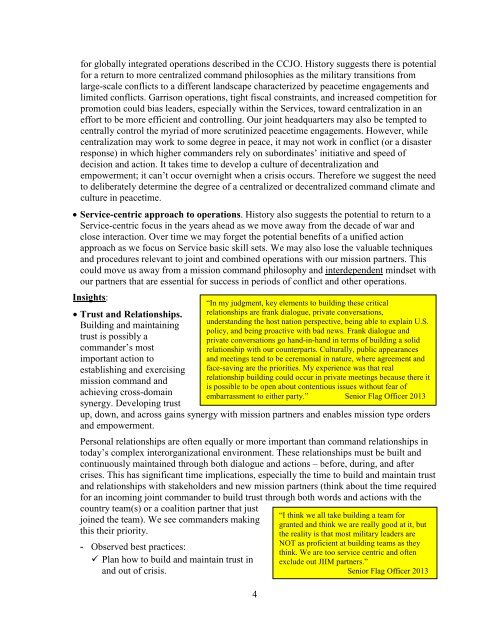Mission Command and Cross-Domain Synergy - Defense ...
Mission Command and Cross-Domain Synergy - Defense ...
Mission Command and Cross-Domain Synergy - Defense ...
- No tags were found...
You also want an ePaper? Increase the reach of your titles
YUMPU automatically turns print PDFs into web optimized ePapers that Google loves.
for globally integrated operations described in the CCJO. History suggests there is potentialfor a return to more centralized comm<strong>and</strong> philosophies as the military transitions fromlarge-scale conflicts to a different l<strong>and</strong>scape characterized by peacetime engagements <strong>and</strong>limited conflicts. Garrison operations, tight fiscal constraints, <strong>and</strong> increased competition forpromotion could bias leaders, especially within the Services, toward centralization in aneffort to be more efficient <strong>and</strong> controlling. Our joint headquarters may also be tempted tocentrally control the myriad of more scrutinized peacetime engagements. However, whilecentralization may work to some degree in peace, it may not work in conflict (or a disasterresponse) in which higher comm<strong>and</strong>ers rely on subordinates’ initiative <strong>and</strong> speed ofdecision <strong>and</strong> action. It takes time to develop a culture of decentralization <strong>and</strong>empowerment; it can’t occur overnight when a crisis occurs. Therefore we suggest the needto deliberately determine the degree of a centralized or decentralized comm<strong>and</strong> climate <strong>and</strong>culture in peacetime.• Service-centric approach to operations. History also suggests the potential to return to aService-centric focus in the years ahead as we move away from the decade of war <strong>and</strong>close interaction. Over time we may forget the potential benefits of a unified actionapproach as we focus on Service basic skill sets. We may also lose the valuable techniques<strong>and</strong> procedures relevant to joint <strong>and</strong> combined operations with our mission partners. Thiscould move us away from a mission comm<strong>and</strong> philosophy <strong>and</strong> interdependent mindset withour partners that are essential for success in periods of conflict <strong>and</strong> other operations.Insights:• Trust <strong>and</strong> Relationships.Building <strong>and</strong> maintainingtrust is possibly acomm<strong>and</strong>er’s mostimportant action toestablishing <strong>and</strong> exercisingmission comm<strong>and</strong> <strong>and</strong>achieving cross-domainsynergy. Developing trust“In my judgment, key elements to building these criticalrelationships are frank dialogue, private conversations,underst<strong>and</strong>ing the host nation perspective, being able to explain U.S.policy, <strong>and</strong> being proactive with bad news. Frank dialogue <strong>and</strong>private conversations go h<strong>and</strong>-in-h<strong>and</strong> in terms of building a solidrelationship with our counterparts. Culturally, public appearances<strong>and</strong> meetings tend to be ceremonial in nature, where agreement <strong>and</strong>face-saving are the priorities. My experience was that realrelationship building could occur in private meetings because there itis possible to be open about contentious issues without fear ofembarrassment to either party.” Senior Flag Officer 2013up, down, <strong>and</strong> across gains synergy with mission partners <strong>and</strong> enables mission type orders<strong>and</strong> empowerment.Personal relationships are often equally or more important than comm<strong>and</strong> relationships intoday’s complex interorganizational environment. These relationships must be built <strong>and</strong>continuously maintained through both dialogue <strong>and</strong> actions – before, during, <strong>and</strong> aftercrises. This has significant time implications, especially the time to build <strong>and</strong> maintain trust<strong>and</strong> relationships with stakeholders <strong>and</strong> new mission partners (think about the time requiredfor an incoming joint comm<strong>and</strong>er to build trust through both words <strong>and</strong> actions with thecountry team(s) or a coalition partner that justjoined the team). We see comm<strong>and</strong>ers makingthis their priority.- Observed best practices: Plan how to build <strong>and</strong> maintain trust in<strong>and</strong> out of crisis.4“I think we all take building a team forgranted <strong>and</strong> think we are really good at it, butthe reality is that most military leaders areNOT as proficient at building teams as theythink. We are too service centric <strong>and</strong> oftenexclude out JIIM partners.”Senior Flag Officer 2013
















